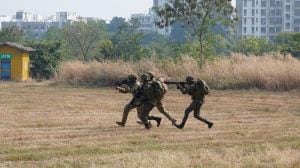To heal old wounds, catch ’em young, say Lanka teachers
COLOMBO, Oct 28: A group of schoolteachers from villages bordering the war zone in Sri Lanka believe textbooks should be rewritten if the...

COLOMBO, Oct 28: A group of schoolteachers from villages bordering the war zone in Sri Lanka believe textbooks should be rewritten if the racial divide between majority Sinhalese and minority Tamils is to heal.
Ethnic hatred is being fanned in classrooms through texts that reinforce myths and half-truths and do not reflect the Indian Ocean island’s multi-culturalism, the Teachers for Peace group said.
From hamlets near Anamaduwa town, some 160 km northwest of Colombo, the teachers said they believe conflict resolution efforts need not be centred in the capital city. It can begin in schools through an educational system that discourages racism.
According to schoolteacher Sidney Marcus Dias, a member of the group, education could play a major role in restoring harmony in the multiracial island, by strengthening religious, social and cultural understanding.
As a first step, the group has published a guide titled The Role of the School Textbooks for Multi-social Reconciliation in Sinhala
andhopes to put out a Tamil version soon, they said here.
The guide is the result of discussions among group members who cycled long distances, to congregate in humble homes, literally burning the midnight oil — as some villages are still without electricity.
Over the weeks, they analysed and evaluated prescribed texts for six subjects in the school syllabus and problems teachers face when attempting to promote co-existence among students.
Since 1983, Sri Lanka has been wracked by civil war in the north and east, between the Sinhalese-dominated government and Tamil tiger rebels, who claim to represent the minority community.
Peace is what Sri Lanka is hankering after, the teachers said. Some would like to achieve it through a military solution, others through devolution, and still others through unconditional talks with the Liberation Tigers of Tamil Eelam, the guerrilla group.
Education, they said, would be the key to peace for teachers. Textbooks, the basic learning tool of children, influencestheir feelings and ways.
What sparked the group’s interest in conflict resolution? Anamaduwa is a `border’ area, short of the war zone where government troops and Tamil rebels are fighting. It also has a proportionately mixed ethnic population. Only 2.5 million of Sri Lanka’s 18 million people are Tamils.
Many border villagers have lost sons or daughters, fathers or mothers in the fighting. The teachers recalled carrying coffins and burying youth they had taught not so long ago, while some others who joined the military have come back maimed by war.
With some younger children in their schools organising themselves into `peace groups’ and seeking teachers’ assistance, the need for war was questioned for the first time in their schools, they said.
This led dedicated teachers to look deeper into the conflict and wonder whether the misunderstanding between communities was partly because of `confused’ textbooks.
There was a realisation that as teachers they could play a crucial role in restoring peace.Dias said most attempts to bring about peace have been centred around Colombo with hardly any activity in other parts of the country.
“We looked at the subjects not connected to peace at all. Then it emerged that children should be led away from racism,” Dias explained.
For instance, the well known medieval battle between Dutugemunu and Elara, two regional kings, has been interpreted by Sinhalese extremists in their own way with a view to whipping up racial hatred. In the textbooks too, the incident is described as a `war’ between Sinhalese and Tamils.
But historical evidence shows that the battle was for territory and had nothing to do with religion or ethnic superiority. There is even mention of a Tamil Buddhist monk called Buddhagosha Thera in the same period.
Also the Mahavamsa, the historical chronicle of Sri Lanka, portrays Elara as a righteous king, quite contrary to what textbooks say today.
According to Gamini Kumarasinghe, another teacher, the country’s education policy has alwaysemphasised the need to work towards peace. As far back as 1943, even before independence, eminent educationist C W W Kanangara — regarded as the father of free education — visualised education as something that forged unity among the different communities, propagated tolerance and helped build character.
From then on, recommendations or proposals on education have underlined the national need for unity and that education should perform this function. Even the government’s national education policy stressed the need for unity in diversity, but it is not reflected in school textbooks.





- 01
- 02
- 03
- 04
- 05


























